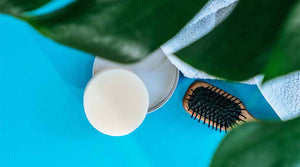Your Cart is Empty
💗FREE shipping on Oprah's Favorite Dog Walking Bag! Everything ships FREE on orders over $30 💗
💗FREE shipping on Oprah's Favorite Dog Walking Bag! Everything ships FREE on orders over $30 💗
💗FREE shipping on Oprah's Favorite Dog Walking Bag! Everything ships FREE on orders over $30 💗
💗FREE shipping on Oprah's Favorite Dog Walking Bag! Everything ships FREE on orders over $30 💗
Add description, images, menus and links to your mega menu
A column with no settings can be used as a spacer
Link to your collections, sales and even external links
Add up to five columns
Add description, images, menus and links to your mega menu
A column with no settings can be used as a spacer
Link to your collections, sales and even external links
Add up to five columns
February 01, 2024 10 min read
The future of product packaging is changing as more companies embrace sustainable packaging. As the war on plastic continues, innovative businesses like Puppington are coming up with new, more eco-friendly ways to repackage their products and make them appealing to environmentally-conscious consumers.
Various sustainable packaging solutions are replacing plastic. Some popular alternatives include amber glass, paper tubes, and aluminum packaging.
Sustainable living is the best practice at this point in our planet’s journey, and one of the best ways that we can all play our part is by switching to eco-friendly packaging solutions for the products we love.
It can seem overwhelming to start leading a life that leads to less waste, but there are ways to find the best sustainable packaging solutions on the market. Read on to see what they are!
One great way to reduce waste is to opt for smaller shipping packaging to reduce mailer's waste. For instance, aluminum eco-friendly pouches are ideal for shipping food items. The aluminum packaging is flexible and is large enough to hold the contents inside. This eliminates the need for using plastic food containers or plastic bottles, which leave a lot of unused space and are not as eco-friendly.
For example, we are already seeing a new trend in sustainable dental packaging that features eco-friendly aluminum toothpaste tubes. This is a sustainable shift away from conventional toothpaste packaging, which was made from an alloy of metals that is hard to recycle.
Another way to identify and use sustainable packaging is to make sure that packaging is sourced from plant-based raw materials, like paper tubes made from wood pulp. Many types of plant-based packaging can be composted when you’re done with them!
Many products themselves are being made from plant-based material. An example is the rise of bamboo toothbrushes and bamboo dog brushes which are replacing conventional plastic toothbrushes and hairbrushes. Bamboo ranks high as one of the most renewable resources. Bamboo trees grow rapidly and are harvested within four years, which makes them very sustainable. Also, bamboo is tough and water-resistant, making it excellent for handles of toothbrushes and pet combs.
It’s important to watch out for some plant-based packaging types that may not be as sustainable, even if they are made from the earth. For example, packaging made out of things like wheat and corn is actually unsustainable because these industries compete with the food industry, driving the prices of food higher. That’s why it’s so important to select quickly-renewable plant-based packaging like bamboo!
Compostable packaging is an awesome option for the earth–and it can be an awesome one for you, too! Compostable packaging can be made into a nutrient-rich fertilizer over time. Paper tubes and bamboo are two materials that are 100% compostable. While shopping for eco-friendly packaging, look out for packages labeled as compostable.
Biodegradable packaging is also a great option. While not always able to be composted, biodegradable packaging easily breaks down without leaving behind any toxic impurities in the environment.
A quick disclaimer to help you with your shopping– the word “biodegradable” is not a regulated term. Manufacturers use the word to mean their products are eco-friendly. However, biodegradable does not equate to eco-friendly, especially if the material in question can take years to break down. A biodegradable product is ranked as eco-friendly if it decomposes within the shortest time possible.
Some sustainable packaging methods are being called by a new name: “refillutionaries.”
So, what are Refillutionaries?
The term “refillutionaries” describes the wave of eco-conscious individuals and companies supporting the refillution (or the refill revolution–don’t worry, it took us a second to learn the lingo too). This refillution is replacing single-use plastic packaging with refillable options.
Why are refillutionaries important?We have every reason to fight for the minimization, or complete elimination of, single-use plastics and hard-to-recycle plastics around the world. Despite previous efforts to advance the war on plastic, the COVID-19 pandemic brought a significant setback.
The pandemic saw the rise of single-use plastics, largely because of PPE masks and other single-use equipment. According to Discover Magazine, our bid to protect ourselves from the pandemic has resulted (so far) in about 1.6 billion facemasks ending up in our seas. That is about 6 tons of new plastic waste in our oceans, and it can take up to 500 years for these plastics to disintegrate. This is without even counting surgical gloves and sanitizer bottles, whose consumption increased during the pandemic also.
Why is plastic packaging so bad?
We’ve all been warned against using plastic before, but learning more about its effects is never a bad idea. We know that most single-use plastics end up in the landfill and never fully decompose. But the plastics that don’t make it to the landfill end up in even more harmful places, such as the land and the oceans, causing even more pollution.
We know the main reasoning as to why plastic packaging should be avoided, but the issue is even deeper than waste. The problem with plastics does not just lie in their after-use pollution. The process of making the plastic used for packaging releases massive amounts of greenhouse gasses. No part of plastic production or consumption is good for our earth, and it’s incredibly important to prioritize packaging made from more sustainable resources!
|
RECYCLING |
COMPOSTING |
|
|
|
|
|
|
|
|
|
|
|
|
Recycling never goes out of fashion as far as eco-friendly waste-management solutions are concerned, but it is not always the best option. Recycling involves breaking down waste into raw materials used to make new products. Glass and aluminum are easy to recycle without losing their quality. Other recyclable items include batteries and fabrics.
Recycling is a global initiative. It helps reduce your carbon footprint as well as the amount of plastic waste in landfills and oceans. Any non-biodegradable product will benefit from recycling, as they are reused and given a new purpose after recycling is finished.
While recycling is a great option when it comes to reducing your carbon footprint, avoiding waste in the first place is even better. One way to avoid waste is through composting! When you compost something, you return it to the earth and soil instead of allowing it to sit in a landfill or using energy to recycle it. But here’s the catch: only certain things can be composted, like food waste, some paper products, and cardboard. It’s important to do your research to make sure you are composting the right items!
The refillutionary movement provides us with another way to avoid waste: by reusing packaging! Recycling is helpful, but the world is slowly shifting from recycling plastic toreducing plastic. Reducing our use of plastic and reusing the plastic that we do have to use helps make single-use plastic less common. The refillutionary movement is helping us keep the planet clean and lower emissions!
With the increasing negative impact of plastics on the environment, many industries and businesses have begun to rethink their packaging strategies–with good reason! The dry foods, cosmetics, and household industries are at the forefront of embracing the refillutionary way of repackaging and presenting their products to consumers.
At Puppington, we are heading in the right direction, too!
Glass has been a sustainable way to package products for a very long time. Not only does glass have a beautiful look, but it is also easily recyclable and eco-friendly. Glass is a non-porous material that keeps products safe from contamination.
In addition, glass does not begin to break down and leach chemicals into whatever product is inside. One can mold glass into safe, decorative packaging. Glass packaging is becoming a trend in the beauty and personal care industry.
Amber glass bottles have more advantages than conventional glass bottles. The amber color has protective qualities that prevent light from compromising the contents of the glass packaging. Amber glass is excellent for creating packaging for products that are sensitive to blue or UV light.
All of these reasons are why the flagship Pup Wax® collection was packaged in amber glass jars!
For example, beer can go rancid when exposed to direct light. Photons in light interact with beer molecules, transforming their chemical composition. This chemical reaction can affect the flavor of the beer– usually not for the better! But amber glass often saves the day in this situation.
Amber glass also blocks harmful wavelengths of light from breaking down the composition of essential oils through oxidation. As a result, the glass packaging maintains the aroma, viscosity, and overall quality of essential oils.
Amber glass is eco-friendly and sustainable. About 45% of glass is recycled to produce amber glass containers. You can never go wrong with glass, and when you add the UV protective advantage of amber, it adds the benefit of increased shelf life of your product.
Paper tubes
Paper tubes are another environmentally-friendly option that businesses and industries can choose for packaging their products. Like glass, paper is recyclable, but it also has the added advantage of being biodegradable and sometimes even compostable. In fact, at Puppington, we recently made a packaging switch to paper tubes with ourPup Wax Limited Edition Magic Stick! Sustainability is incredibly important to us as a company, so we’ve changed our packaging to be gentler on the environment.
Paper tubes are made from 100% recyclable and biodegradable paper. Cardboard is a popular material for making paper tubes. Companies can use it plain or add color to improve the aesthetic of the packaging.
Paper tubes are plastic-free and ideal for packing non-perishable products. However, perishable items like dry foods require a different paper tube for preservation. Paper tubes used in packing foods have tin foil or plastic lining. This protective layer keeps the food safe from water or outside odors.
The foil and plastic protect the foods from soaking the paper packaging. In addition, this inner protective layer bars outside odors or solvents from leaching into the packaged product, helping to preserve its quality and shelf-life.
Paper tubes are often food–safe
Paper tubes aren’t just eco-friendly… they’re also food-safe much of the time! Paper tubes made from a composite of paper and aluminum foil are usually food safe. The aluminum or PE lining inside creates an oil-resistant barrier and ensures the product inside is uncontaminated. In addition, these packaging tubes are sealed air-tight for added protection.
Paper tubes can be cut into different sizes and styles. This allows businesses to achieve a unique look for their packaging while ensuring production remains eco-friendly. Different sizes and styles of paper tubes suit various applications. Because they can feature many different colors, paper tubes are one of the most attractive types of packaging!
Common types of cardboard tubes include:
Small paper tubes are tiny, spiraled, and are the size of thick straw. They are custom-made and have a sturdiness that makes them suitable for packaging solutions where precision is required.
Specialty tubes are made from a tougher material to suit their specific uses. The commonly used material is Poly Kraft or glassine paper. Compared to other paper tubes, specialty tubes have a smoother surface.
Eco-tubes are a composite of two or more materials. These are an improved version of the previous composite tubes that had a plastic or aluminum lining. Eco-tubes are made from a combination of recycled board andFSC-sourced paper. They are used in the beer and cosmetic industries.
Paper tubes can be cut and molded into three different styles. The most common style is the 1-piece tube with an aluminum or plastic enclosure. There are also 2-piece telescopic tubes with straight or rolled edges from the top to bottom. These tubes have a cap that fits the base snugly when the tube is closed. The third style of paper tubes is the 3-piece telescopic tube. It features three layers of paper to achieve its thickness and has a straight or rolled surface as well.
Paper tube packaging is lightweight and requires less energy to ship. Using paper tubes reduces the cost of shipping and minimizes carbon emissions, too!
Paper tubes are compostable only if made from 100% pure wood pulp. Most refill tubes feature cheaper recycled paper. Unfortunately, mixing organic wood pulp with recycled paper introduces impurities into the pulp. This results in a paper tube packaging that is unfortunately non-compostable. However, most paper tubes are still biodegradable, even if they do contain some impurities.
Pure wood pulp is a product of sulfate-coniferous wood. Paper tubes made from organic pulp have a smoother profile. The paper produced is strong and tough. It has long, visible fibers when ripped apart.
You can tell if your paper tube is compostable by checking the manufacturing details on the product label. Here you can see all the ingredients used in manufacturing the paper tube and where the ingredients are 100% biodegradable.
In a nutshell, types of paper that are not compostable include;
Unfortunately, paper tubes with plastic or aluminum foil lining are non-compostable. Composting is only possible if you can separate plastic from paper. Remember to make sure that the paper is 100% natural wood pulp before composting!
Aluminum packaging
Aluminum packaging is another growing trend in the refillutionary world. Like paper tubes, aluminum has the benefit of being lightweight and recyclable. Most of the aluminum in the world is recycled, making this material very eco-friendly. You can recycle aluminum seven times and still get the same quality packaging.
Another benefit of aluminum is its flexibility. This flexibility comes in handy specifically when designing refill packages of various shapes, sizes, and styles. Aluminum is also corrosive-resistant. Used on the right product, it will not leach toxins (unlike some other materials) making it safe for packing items like food or essential oils.
However, aluminum has its weaknesses, especially when it comes to packaging food items that contain acids or salt. These two elements are highly reactive and will damage the aluminum surface. Manufacturers add a thin plastic layer inside the aluminum pouch to protect it from acids and salts. Fortunately, this aluminum-plastic combination uses 70% less plastic, making it relatively safe for the environment.
Biodegradable shampoo bars
Compared to traditional shampoo bottles, shampoo bars are much more eco-friendly. They are plastic-free and zero-waste compared to liquid shampoo.MakeGrowLab, a giant in the cosmetic world, is a very impressive example of the growing popularity of shampoo bars. They have reinvented sustainable packaging for their shampoo bars, using eco-friendly product wraps trademarked as SCOBY. MakeGrowLab manufactures the SCOBY wrapping using a culture of yeast and bacteria. The result is an eco-friendly shampoo bar wrapping that is 100% water-resistant and biodegradable.
Conclusion
The term refillutionary describes the replacement of single-use plastics with returnable and refillable packaging solutions. Amber glass, paper tubes, and aluminum are the standard materials for refill packaging and pouches that contribute to less plastic polluting the environment.
At Puppington, we are partnering with brilliant eco-friendly manufacturers to create, refill, or return packaging for our upcoming products. Our refillable/returnable packaging will be multi-use, which means our beloved consumers can use them multiple times without the packaging losing its quality. By shifting to eco-friendly refillable packaging solutions, we can reduce the waste generated by shipping mailers and contribute to a more eco-friendly and sustainable environment!
References



Comments will be approved before showing up.